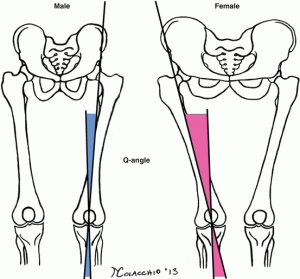Battle of the Sexes: Women’s Knees VS Men’s Knees
Dr Mia Antonopoulos
As the VFLW and the AFLM competitions draw to a close, many a team has been cruelled by the curse of the Anterior Cruciate Ligament (ACL) rupture. But it’s the women in the AFLW and VFLW competitions that are up to 8 times more likely to rupture their ACL than their males counterparts.
Why is that?
Let’s look into why this is the case and how we can reduce the risk of injury.
- Q-angle: the angle between the quadriceps (thigh) tendon and the patella tendon.
- the average Q-angle for men is approximately 14 degrees; whereas for women it is approximately 17 degrees.
- The wider pelvis and increased Q-angle in females is linked to the higher number of knee injuries, in particular ACL injuries, in women due to the decreased knee stability and decreased shock absorption properties in the knee.
- Footy boots: almost all football boots are designed for men. They don’t take into consideration the anatomical differences between females and males . There are four main differences when comparing women’s and men’s feet:
- A narrower heel cup (where the shoe grips the heel) in females
- A wider forefoot in males
- Different arch heights and lengths
- Wider hips (increased Q-angle; resulting in women weight-bearing through their feet differently to men).
- Hormones: during women’s menstrual cycles, oestrogen levels fluctuate. An increase in oestrogen can see a reduction in tendon and ligament stiffness, which is required during childbirth, but can also leave women more susceptible to tendon and ligament injuries.
- Apprehension in contact sports: from a young age, boys are encouraged to be physical and partake in contact sports, whereas for many years girls were encouraged to play non-contact sports. This has led to a greater level of apprehension in girls when it comes to tackling or entering into contests. The hesitation and lack of understanding or knowledge when entering into a contest can result in improper technique being used, which typically tends to result in injury.
What should you do to decrease your risk:
- Boots: Orthotics can be a good addition, if you wear footy boots with low support (such as Nike, Adidas boots). Boots such as Asics can provide the foot more support, without the extra expense of orthotics.
- X-Blades are currently the only football boot manufacturers in Australia who make boots for women. The boots have been made to fit women’s feet and provide support to help stabilise movements and assist with the impact your body takes.
- Exercise Physiology: seeing an exercise physiologist to get an assessment done and a personalised program written to help strengthen any weaknesses that may be present.
- Osteopathy: booking an Osteopathic assessment is one of the best things you can do for your body. The holistic approach taken by Osteopaths in their diagnosis and treatment looks at the way in which the structure and function of your body are reciprocally interrelated. Without knowing it, you may have compensatory patterns present that are leaving you more susceptible to injuries. Osteopaths can also help with any of those recurring niggles that you might feel, and help to reduce the chances of you sustaining a season ending injury.






